Spectacular finds from Kleinbasel
While monitoring extension work currently being carried out on the district heating system in Kleinbasel, the Archaeological Service of Canton Basel is gaining fascinating insight into the history of this part of the city. Burials dating from the Early Middle Ages (c. 6th to 8th centuries AD) provide us with information about how people lived and died in a period of which little is known.
Basel, AD 1615 - a bird's eye view of Kleinbasel
-
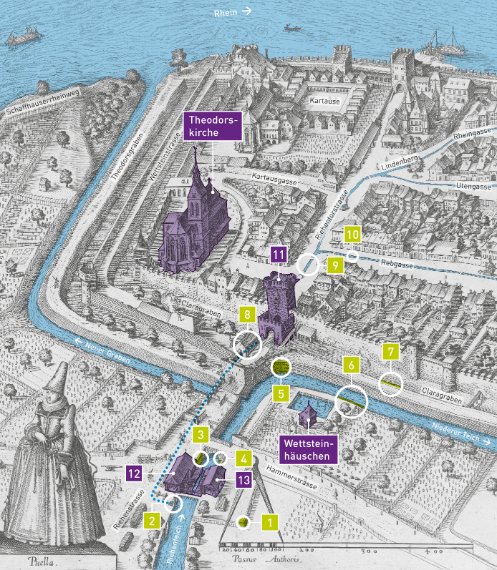
-
Bild vergrössert anzeigen
In 1615 Matthäus Merian created this bird’s eye view of the city. It is one of the earliest and most detailed depictions of Basel. When archaeological features come to light, we can consult this plan for information about buildings that have long been demolished. It also includes many of the buildings that are still in existence today. Reworked by Peter von Holzen.
Attested to by archaeological finds and features:
1. Working pit with fragments of moulds for casting bells
2. Canal junction
3. Canal wall
4. Abutment of the bridge across the canal
5. Canal wall
6. Canal wall
7. Countermure outside of the city wall
8. The “Kenel” canal ran through the Riehentor gate into the city
9. Canal
10. Canal
11. Riehentor gate with forebuilding
12. Municipal sawmill
13. Bark mill
Why are we excavating?
To incorporate the Wettstein quarter into the district heating system, extensive construction work has to be undertaken. This work is being monitored by the Archaeological Service.
The excavation results
So far, 18 early medieval burials have come to light in the narrow pipe trenches. While we have known of the existence of an early medieval cemetery at Riehentorstrasse since the 19th century, the new discoveries have provided information about its actual size. Some of the deceased were buried with luxurious grave goods; a young girl, for instance, was laid to rest with approximately 380 glass and amber beads, and a woman’s remains were found with a gold brooch. Others, however, were interred without any grave goods but in graves lined with massive stone slabs. Overall, the graves bear witness to the fact that the deceased were given elaborate burials.
It is not just the graves and grave goods that provide information about the dead; the skeletons themselves also tell some fascinating stories and allow the experts to find out more about the age, the state of health and the potential injuries of the deceased. The skeleton of a swordsman, for instance, which bears a healed slash wound to the face, tells us about the dangers that existed at the time and also shows how knowledgeable early medieval doctors were. While such a serious injury would have disfigured a person for life, it was not necessarily fatal.
The oldest evidence, however, does not date from the Early Middle Ages. A small number of finds show us that people have lived here since Roman times and probably even since the Bronze Age.
The Late Middle Ages and the early modern period also left behind traces. Several sections of the «Riehedyych», a medieval canal, and various saw, bark and flour mills uncovered by the excavations attest to the continuous modernisation of the quarter. The Riehentor gate and individual remains of the once monumental city wall were also documented. They provide us with important new insight into the late medieval city fortifications.
Finds from the Bronze Age to the early modern period
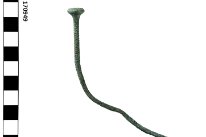 Zoom
Zoom
Basel, 1300 BC - a dress-pin
A dress-pin from the Bronze Age.
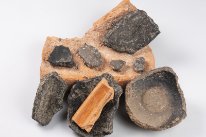 Zoom
Zoom
Basel, AD 374 - From the ditch
One of the features unearthed by the excavations was a ditch with a depth of 1.5 m. Its fill contained Roman and early medieval pottery as well as other finds. The ditch may have enclosed the Late Roman munimentum or a settlement associated with it; further research will have to be carried out to clarify the details. Photo: Léonard Holzer.
 Zoom
Zoom
Basel, AD 374: A small Late Roman fort
The excavations also uncovered a small Late Roman fort. Together with other forts and numerous watchtowers, it secured the Roman border, which at the time was formed by the Rivers Rhine, Iller and Danube. We may even know the name of the Basel fort. The Roman historian Ammianus Marcellinus mentions a fort (munimentum) near Basel, which was founded in AD 374 and was known by the name Robur. Reconstruction: Marco Bernasconi.
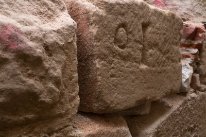 Zoom
Zoom
Basel, 13th – 19th centuries - the city wall
The city walls and gates of Kleinbasel were erected over the course of the 13th century. The walls enclosed and protected the settlement on the right bank of the River Rhine. Parts of the fortification were examined during the recent excavations. The marks and symbols on the stones indicated their position within the wall and thus would have served as orientation guides during construction. Photo: Adrian Jost.
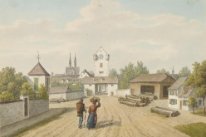 Zoom
Zoom
Basel, 13th century AD – 1864 - the Riehentor gate
The Riehentor was one of two gates in the late medieval fortification of Kleinbasel. The 19th century city expansion led to the walls and gates becoming defunct. The Riehentor gate was demolished in 1864. Remains of the foundations and the forebuilding were rediscovered during the recent excavations. Picture: StABS: BILD Schn. 218.
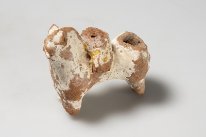 Zoom
Zoom
Basel, AD 1500 - Horse with knight
Small rough clay figurine of a toy horse (with knight). Around AD 1500. Photo: Philippe Saurbeck
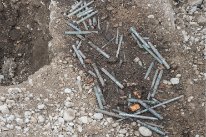 Zoom
Zoom
Basel, 19th and 20th centuries - from the canal fill
Throughout the 19th and 20th centuries, the dye works on the Riehenteich canal gradually evolved into the chemical and pharmaceutical industries of modern-day Basel. As this photograph of glass stirring rods from the canal fill shows, they also left behind traces in the Kleinbasel soil. Photo: Adrian Jost.
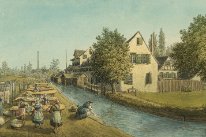 Zoom
Zoom
Basel, 13th – 20th centuries - the Riehenteich canal
The «Riehendyych» canal supplied water from the River Wiese to both the residents of Kleinbasel and the trades which required vast quantities of it, for instance the dyers and tanners. Up to 26 flour, bark, saw and fulling mills were located in this particular area of the city. Picture: StABS, BILD Schn.235.
A girl with beads
Basel, c. AD 580
Died young – buried with rich furnishings
Apart from a belt buckle with gold inlay and a small bag or purse, the severely disturbed grave of a c. 12-year-old girl contained a large number of beads. It was rather unusual for such a young girl to be buried with so many beads.
The early medieval beads were made of glass, amber and mother-of-pearl. Some had been traded over vast distances, possibly from as far away as India or Southeast Asia. The beads were either part of one or several necklaces or were perhaps sewn onto the girl’s clothing.
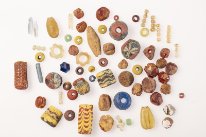 Zoom
Zoom
Basel, c. AD 580 - A girl with beads
Early medieval beads were made of glass, amber and motherofpearl and came in a variety of shapes and colours. Such beads not only provide us with an insight into the techniques and routes of trade and exchange; they also contain information about early medieval fashion and point to social roles and identities. The elaborate grave goods in this burial suggest that the girl had an elevated position in early medieval society. The grave furnishings are more reminiscent of those of an adult woman. Perhaps the girl was about to enter or was already considered to have reached adulthood. Photo: Philippe Saurbeck.
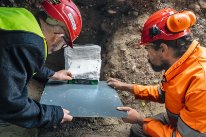 Zoom
Zoom
Basel, c. AD 580 - A girl with beads
Precision work at the excavation in the Wettstein quarter: staff from the Archaeological Service insert a sheet of metal beneath the block of soil which has been encased in plaster, and separate the entire section that contains the girl’s skeleton from the underlying sediment. This is the most important and at the same time the riskiest moment in the block-lifting process. While the block must not be too small, it should not be too heavy either. Photo: Adrian Jost.
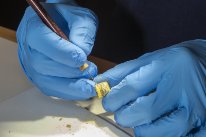 Zoom
Zoom
Basel, c. AD 580 - A girl with beads
Back in the conservation laboratory, the beads are painstakingly and carefully cleaned. Over the centuries in the ground, the beads have deteriorated and must be stabilised. It is possible to date them based on their shapes. Because of the bead types in the grave, we can say that the burial probably dates from the late 6th century. Photo: Philippe Saurbeck.
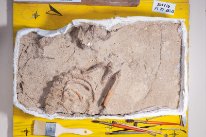 Zoom
Zoom
Basel, c. AD 580 - A girl with beads
Due to the special circumstances in which the burial was found, it was decided that it would be best to secure the undisturbed section of the feature by wrapping it in plaster bandages, carefully lifting it as a whole and excavating it in the portacabin on site. This meant that the skeleton and the rich assemblage of beads could be examined in detail and without time constraints, which would not have been possible in the middle of a busy construction site. During the excavation in the portacabin, the precise position of each artefact was recorded; in the end the finds included approximately 380 beads, a buckle – the clasp of possibly a small bag or purse – and a belt buckle with gold inlay. Similar assemblages have so far only been found in richly furnished women’s graves. Photo: Philippe Saurbeck.
 Zoom
Zoom
Basel, c. AD 580 - A girl with beads
When the block was excavated, the precise position of each individual bead and of the belt buckle was recorded, so that we can now create a three-dimensional visualisation of their distribution within the grave. This allows us to see whether the beads were perhaps sewn onto the girl’s clothing or came from necklaces. However, the processes of decay and other influences have led to them being widely dispersed. Graphic representation: Tobias Steiner, Steiner Virtual Productions.
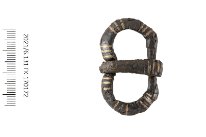 Zoom
Zoom
Basel, c. AD 580 - A girl with beads
Belt buckle, 6th century AD, iron, gold. Photo: Philippe Saurbeck.
A precious grave offering: a gold brooch
Basel, early 7th century AD
The art of goldsmithing
This gold brooch from the grave of a c. 40-year-old woman served as a cloak fastener. Its decorations made of gold wire with inlays of blue glass and light-green garnets attest to the specialist skills of early medieval goldsmiths.
Besides the gold brooch, the 7th century grave contained other pieces of precious jewellery and dress accessories, including 160 beads, parts of belts, a châtelaine with perforated Roman coins and a decorative leather strap with cruciform mounts. The rich furnishings attest to the high social standing of the deceased.
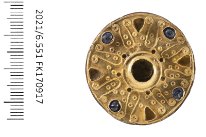 Zoom
Zoom
Basel, early 7th century AD - A precious grave offering: a gold brooch
This gold disc brooch came from the richly furnished grave of a c. 40-year-old woman. It was used to fasten a cloak and attests to the artistic skills of early medieval goldsmiths. The brooch has a base plate made of nonferrous metal. It is covered with a gold disc. The decoration consists of goldwire filigree as well as inlays made of blue glass and lightgreen garnets. Besides this brooch, the woman wore precious jewellery on her torso consisting of approximately 160 glass, amethyst and amber beads. Photo: Philippe Saurbeck.
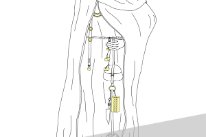 Zoom
Zoom
Basel, early 7th century AD - A precious grave offering: a gold brooch
Reconstruction of the clothing and jewellery. Graphic representation: Heidi Colombi, Léonard Holzer.
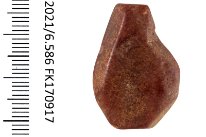 Zoom
Zoom
Basel, early 7th century AD - A precious grave offering: a gold brooch
Large bead, 7th century AD, amber. Photo: Philippe Saurbeck.
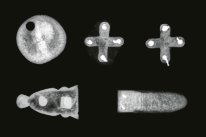 Zoom
Zoom
Basel, early 7th century AD - A precious grave offering: a gold brooch
Perforated Roman coin, cruciform mounts, strap fittings, 7th century AD, non-ferrous metal (from top left to bottom right). X-ray image: ABBS.
A comb and a pair of scissors
Basel, late 6th century AD
A richly furnished boy’s grave
Large belt mounts with metal inlay, a comb and a pair of scissors were placed in the grave of this 5 to 9-year-old boy.
The metal belt mount was decorated with inlay consisting of metal of a different colour. Inlays used in similar finds were often made of light-coloured silver or brass, which stood out against the darker coloured iron, making them look particularly attractive. A bone comb and a pair of scissors were found near the right upper arm of the child. The items had been wrapped in a coarse type of fabric before being placed in the grave.
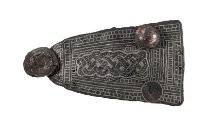 Zoom
Zoom
Basel, late 6th century AD - A richly furnished boy’s graveng
This belt mount was found in a grave dating from the 6th century, which contained the remains of a boy between 5 and 9 years of age.
Belt mount with metal inlay guilloche decoration, 6th century AD, iron, silver. Photo: Philippe Saurbeck.
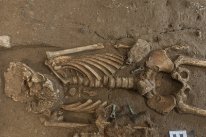 Zoom
Zoom
Basel, late 6th century AD - A richly furnished boy’s grave
Other grave goods included a pair of scissors, a bone comb and parts of a belt. Photo: ABBS.
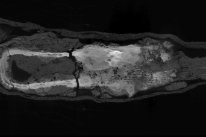 Zoom
Zoom
Basel, late 6th century AD - A richly furnished boy’s grave
The scissors made of iron and the comb were probably wrapped in fabric before they were placed in the grave. Computed tomography: ABBS.
A swordsmen
-
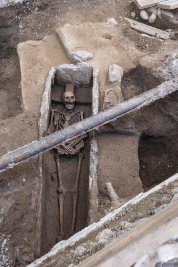
-
Bild vergrössert anzeigen
Basel, 8th century AD
The stone slab grave of a man was uncovered during the excavation. Such graves, also known as stone cists, were typical of the 8th century and are often devoid of grave goods. They are generally presumed to have been used by the upper classes to bury their dead. The skull of the tall man bore evidence of a severe and potentially fatal slash wound to the face. Anthropological analysis, however, showed that the man survived the injury! His wound was carefully attended to and healed very well. While such serious injuries would have disfigured a person for life, they were not necessarily fatal. Photo: Philippe Saurbeck.
-
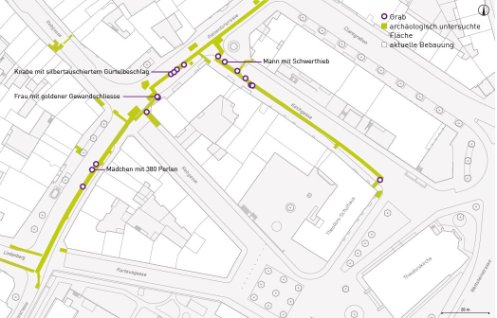
-
Bild vergrössert anzeigen
- The current excavations have so far brought to light 18 early medieval burials. Plan: Peter von Holzen.
Suggested reading
Find out more about the results of the excavation (in German only).
Coverstory «Das Mädchen mit den Perlen» im Jahresbericht 2021
























